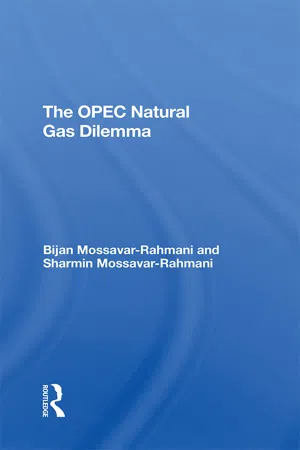![]()
1
Natural Gas and Natural Gas Developments
Origins of Natural Gas Deposits
Geologists believe that crude oil and natural gas were largely created by the gradual burial and compression of organic material under high temperatures beneath the floors of the early oceans. Rocks on the earth's surface were gradually eroded and carried by rivers and streams to the lower valleys and ocean basins. The rivers and streams also picked up decomposed vegetable and animal matter that was deposited with the eroded rock to settle in layers on the ocean floor. This combined material was later buried and compressed by new layers of sediment, which formed strata of limestone, dolomite sandstone, shale, or clay, depending on the physical and chemical characteristics of the material. Over time, the organic compounds that had been deposited in the rock layers formed into crude oil and natural gas. After formation in sedimentary rocks, the crude oil and natural gas migrated through the pores, fractures, and fissures of adjacent overlying rock formations until they were halted by a subsurface rock seal where they accumulated in large volumes, forming reservoirs. The subsurface structures are called traps or reservoirs, and the porosity and permeability of the traps determine the size of the crude oil and natural gas accumulations.
In some instances, crude oil and natural gas are found trapped in the same reservoir; this natural gas is referred to as associateddissolved gas. Associated gas or gas cap is free natural gas that overlies and is in direct contact with crude oil in a reservoir. Dissolved gas is natural gas that is found in solution with crude oil in the reservoir at reservoir conditions. Following convention, associated-dissolved gas will heretofore be referred to simply as associated gas. Production of associated gas is closely related to production of crude oil from the same reservoir; therefore, associated gas production occurs unavoidably with the production of crude oil, and unless otherwise used, must be either flared and wasted or reinjected back into the reservoir for pressure maintenance.
In other instances, natural gas that was originally trapped with crude oil leaked out and migrated upward to shallower reservoirs where it was again trapped. This free natural gas found not in contact with crude oil is described as non-associated gas. Non-associated natural gas is also found at depths below 15,000 feet where the increase in temperature and pressure results in the breakdown of hydrocarbons and in a marked increase in the proportion of non-associated natural gas. The odds, therefore, of finding natural gas rather than crude oil increases sharply with depth. An estimated three-quarters of the world's natural gas reserves is of the non-associated kind and the remainder is associated.
Composition and Properties
Natural gas usually occurs in a gaseous state under pressure. It is composed primarily of methane in percentages reaching 90 to 96 percent of volume and smaller amounts of ethane, propane, butane, and pentane, and nonhydrocarbon components (such as nitrogen, hydrogen, carbon dioxide, hydrogen sulfide, water vapor, and casual impurities) and traces of rare gases, especially helium, in very small amounts. (See Table 1.1.)
The heavier hydrocarbons such as propane, butane, pentane, and ethane are collectively known as natural gas liquids (NGL). Propane, butane, and mixtures of propane and butane are referred to as liquefied petroleum gas (LPG). LPG can also be obtained from processing crude oil in refineries and as a by-product from chemical plants. Varying mixtures of pentanes and heavier hydrocarbons are referred to as condensates. (See Figure 1.1.)
Finally, natural gas that is saturated with NGL is called "wet gas"; when the liquids and the nonhydrocarbon constituents are largely removed, the remainder is called "dry gas," which is essentially methane. The market, the economics, and the method of transportation of dry gas are very different from those of NGL. This book concentrates on the former, and the term natural gas as used here refers to dry gas unless otherwise specified.
TABLE 1.1:
COMPOSITION OF SELECTED NATURAL GASES (Z volume)
FIGURE 1.1:
CONSTITUENTS OF NATURAL GAS
SOURCE: Shell Oil Company, Natural Gas. London (1983).
Production and Processing
The equipment and techniques used in exploration, production, pipelining, and processing of crude oil and natural gas are very similar. For natural gas to flow through the pores of reservoir rock into a drilled well, the reservoir pressure propelling the natural gas must exceed the air pressure in the well bore. The rate at which the natural gas flows depends on the reservoir pressure at the bottom of the well, as well as on the porosity and permeability of the reservoir rock. As natural gas is gradually removed from the reservoir and pressure falls off, the rate of production, too, declines. After fifteen to twenty years, the average field ceases to produce economically and is abandoned, having reached an average recovery factor of 60 to 80 percent of the gas-in-place compared with an average of 30 to 35 percent of the oil-in-place that can be recovered without resorting to secondary recovery methods.
Not all natural gas fields are commercially viable. The size of the reservoir, the quality of the producing zone, the projected rate of the field's production, the price of natural gas, and the location of the field all determine the commercial value of a reservoir. If initial exploratory test wells show good prospects for profitability, development drilling follows. The time required to devel...


